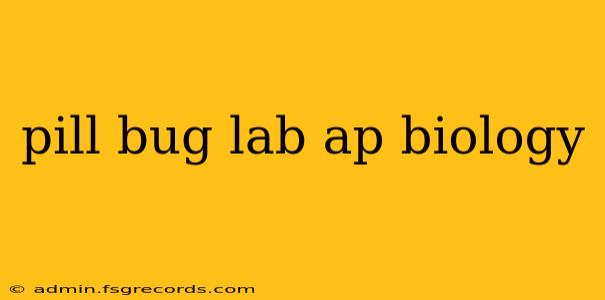The pill bug, also known as the roly-poly or isopod, is a common invertebrate frequently used in AP Biology labs to explore fundamental concepts in animal behavior and ecology. This guide provides a comprehensive overview of a typical pill bug lab, covering experimental design, data analysis, and potential extensions for a deeper understanding of these fascinating creatures.
Understanding Pill Bug Behavior: The Basics
Pill bugs exhibit several interesting behaviors, making them ideal subjects for scientific inquiry. Their primary responses are driven by environmental factors, such as:
- Thigmotaxis: A preference for contact with a surface. Pill bugs often seek enclosed spaces and crevices.
- Phototaxis: A response to light. They generally exhibit negative phototaxis, meaning they prefer darker environments.
- Chemotaxis: A response to chemical stimuli. They may exhibit positive or negative chemotaxis depending on the substance.
- Hygrotaxis: A response to moisture. They prefer moist environments to prevent desiccation.
These behavioral responses can be easily tested in a controlled laboratory setting, allowing students to design and execute experiments to investigate the impact of these environmental factors.
Designing Your Pill Bug Experiment: A Step-by-Step Guide
A successful pill bug lab requires careful planning. Here's a structured approach:
1. Formulate a Testable Hypothesis:
Start by identifying a specific behavioral response you want to investigate. For example:
- Hypothesis 1: Pill bugs exhibit negative phototaxis.
- Hypothesis 2: Pill bugs demonstrate a preference for moist environments over dry environments.
- Hypothesis 3: Pill bugs show a preference for specific types of substrate (e.g., soil versus paper).
Your hypothesis should be clear, concise, and testable through experimentation.
2. Develop Your Experimental Design:
Consider these crucial elements:
- Independent Variable: The factor you manipulate (e.g., light intensity, moisture level, substrate type).
- Dependent Variable: The measurable response you observe (e.g., number of pill bugs in different experimental conditions).
- Controlled Variables: Factors you keep constant to ensure a fair comparison (e.g., temperature, humidity – excluding the moisture level you're testing, pill bug size and health).
- Sample Size: Use a sufficient number of pill bugs in each experimental group (at least 10 per group is recommended) to ensure reliable results.
- Replications: Conduct multiple trials to reduce the impact of random error.
- Control Group: Include a control group to compare the experimental groups against. For example, if testing light preference, a control group might be kept in a dimly lit area.
3. Data Collection and Analysis:
- Quantitative Data: Record numerical data (e.g., number of pill bugs in each condition).
- Qualitative Data: Note any observations (e.g., pill bug behavior, activity levels).
- Statistical Analysis: Use appropriate statistical tests (e.g., chi-square test) to analyze your data and determine if your results support or refute your hypothesis. Your AP Biology teacher will guide you on which test is appropriate for your experimental design.
Beyond the Basics: Expanding Your Pill Bug Lab
Once you've completed a basic pill bug experiment, consider these extensions to deepen your understanding:
- Investigate multiple variables simultaneously: For example, study the combined effects of light and moisture on pill bug behavior. This requires a more complex experimental design but can yield richer insights.
- Explore different species of isopods: Compare the behavioral responses of different isopod species to the same environmental stimuli.
- Examine the impact of environmental pollutants: Introduce a controlled amount of a pollutant (under strict teacher supervision) and observe its effect on pill bug behavior or survival.
Conclusion: Learning from the Pill Bug
The pill bug lab is a valuable learning experience that provides a hands-on approach to understanding scientific methodology, data analysis, and ecological principles. By carefully designing experiments and analyzing data, AP Biology students gain practical skills and a deeper appreciation for the fascinating world of invertebrate behavior. Remember to always follow ethical guidelines for animal handling and ensure the well-being of the pill bugs throughout the experiment. Proper disposal of the pill bugs after the experiment is also essential.

